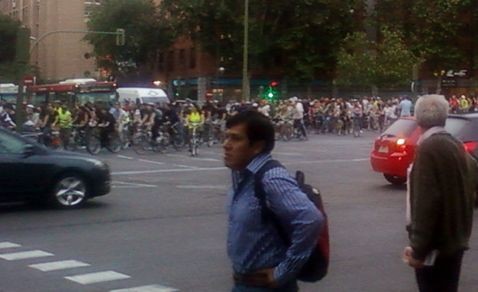
In Madrid last week, up to 3,000 cyclists slowed traffic to a grind in a few of the car-clogged central arteries of the capital city, but according to this blog, riders "made friends with drivers and pedestrians." Meanwhile, In Los Angeles, a Streetsblog report and YouTube clip shows at least one bike rider during a Critical Mass last week purposefully kicked or tripped by police standing by. And then, there's San Francisco, where it all began, and where it still goes each last Friday of the month. Meanwhile, in the arguable capital of U.S. cycling, Portland, Critical Mass rides have nearly disappeared. By its advocates, Critical Mass is deemed to have played a role in giving cyclists a piece of city streets. But has it outlived its usefulness?
Strength in Numbers
Critical Mass has ranged from everything from initial rides of just scores of cyclists to gatherings such as one in Budapest in 2008 that drew approximately 80,000 riders. While some people view them as anarchist social protest rides, others insist that the coming together of cyclists to rides is more of an unorganized yet still regular event that gives riders visibility they lack when riding alone.
In the 20-year history of Critical Mass (the first recorded ride is agreed amont various sources to have been in San Francisco in 1992) there have been lots of peaceful rides, but as one observer and participant in San Francisco rides recently observed, there are a few people that use the crowd as a cover for "exercising their aggression." Over 250 riders were arrested in a San Francisco ride in 1997, while a driver was hauled from his car and hit on the back of the head with a lock in Seattle 2008. And then there's the YouTube video from last year showing a New York policeman slamming a participant to the ground (the slammer was dismissed from the force though felony charges were dropped, the slammee is suing the city). So the strength in numbers principle can be a double-edged sword.
In an article by Jim Gourley that appeared earlier this year in Bicycle Times, the author says Critical Mass has "devolved into chaos." Since Critical Mass was purposefully never formally organized or structured beyond its last Friday of the month scheduled time frame, and different riders ride for different reasons, that might be accurate but not completely to the point.
Portland is a good example of a "friendly" cycling city in the United States where Critical Mass rides have long been popular. However, the police also expressed their frustration that the unorganized nature of the "organization" makes it difficult to respond to, and their presence at rides isn't always friendly. Meanwhile, however, rides have dwindled down in the last couple of years, causing documentarist microcosmpub to label Portland as a "post-revolutionary bike culture."
On the bright side, Critical Mass rides now have to compete with the hundreds, if not thousands, of organized and spontaneous cycling events held in Portland throughout the year. In fact, as we approach June, Portland's Pedalpalooza has nearly 300 organized events in a 10-day period, everything from the Pretty Panty Ride to the Zombie Ride.
Perhaps this is how it should be - cities need Critical Mass so that cyclists can get a piece of the road. If a true critical mass of cyclists develops (Portland's modal share is now around 8 percent, arguably "critical mass"), then perhaps the gradual fading away of the Critical Mass rides shows that their influence has been felt but their physical presence is no longer...critical.
From Treehugger.com
